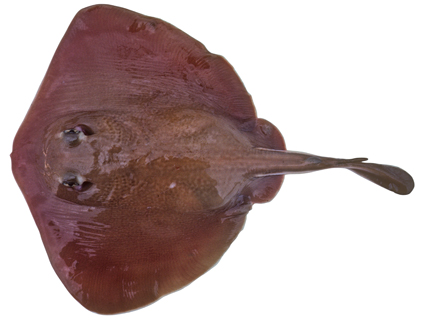- Classification
- CHONDRICHTHYES
- MYLIOBATIFORMES
- UROLOPHIDAE
- Urolophus
- bucculentus
Sandyback Stingaree, Urolophus bucculentus Macleay 1884
Other Names: Great Stingaree, Sandy-back Stingaree, Sandy-backed Stingaree

Sandyback Stingaree, Urolophus bucculentus. Source: Ken Graham. License: CC by Attribution
Summary:
A large offshore stingaree found on soft bottoms on the outer continental shelf and upper slope in south-eastern Australia.
Cite this page as:
Bray, D.J. 2018, Urolophus bucculentus in Fishes of Australia, accessed 06 Jul 2025, https://fishesofaustralia.net.au/home/species/3531
Sandyback Stingaree, Urolophus bucculentus Macleay 1884
More Info
|
Distribution |
Endemic to southeastern Australia from off Stradbroke Island, Queensland, south to the Hippolyte Rocks, Tasmania, and west to Beachport, South Australia, including Victoria. Most common on the outer continental shelf presumably mainly on soft substrates; depth range 65-265 m. |
|
Biology |
Females give birth to live young. Stingarees are aplacental viviparous, meaning that the embryos emerge from eggs within the uterus and undergo further development until they are born. After emerging from their egg cases, the embryos are initially sustained by their yolk, and later by histotroph, a "uterine milk" produced by the mother. |
|
Fisheries |
Taken as by-catch in a number of commercial fisheries throughout its range. |
|
Author |
Bray, D.J. 2018 |
|
Resources |
Australian Faunal Directory |
Sandyback Stingaree, Urolophus bucculentus Macleay 1884
References
Gomon, M.F., Yearsley, G.K. & Last, P.R. 2008. Family Urolophidae. 125-137 pp. in Gomon. M.F., Bray, D.J. & Kuiter, R.H (eds). Fishes of Australia's Southern Coast. Sydney : Reed New Holland 928 pp.
Graham, K.J., Andrew, N.L. & Hodgson, K.E. 2001. Changes in the relative abundances of sharks and rays on Australian South East Fishery trawl grounds after twenty years of fishing. Marine and Freshwater Research 52: 549-561.
Kuiter, R.H. 1993. Coastal Fishes of South-eastern Australia. Bathurst : Crawford House Press 437 pp.
Last, P.R., Scott, E.O.G. & Talbot, F.H. 1983. Fishes of Tasmania. Hobart : Tasmanian Fisheries Development Authority 563 pp. figs.
Last, P.R. & Compagno, L.V.J. 1999. Family Urolophidae. pp. 1469-1476 in Carpenter, K.E. & Niem, V.H. (eds). The Living Marine Resources of the Western Central Pacific. FAO Species Identification Guide for Fisheries Purposes. Rome : FAO Vol. 3 pp. 1397-2068.
Last, P.R. & Gomon, M.F. 1994. Family Urolophidae. pp. 172-181 figs 150-159 in Gomon, M.F., Glover, C.J.M. & Kuiter, R.H. (eds). The Fishes of Australia's South Coast. Adelaide : State Printer 992 pp. 810 figs.
Last, P.R. & Marshall, L.J. 2006. Urolophus bucculentus. In: IUCN 2013. IUCN Red List of Threatened Species. Version 2013.2.
Last, P.R. & Stevens, J.D. 1994. Sharks and Rays of Australia. Canberra : CSIRO Australia 513 pp. 84 pls.
Last, P.R. & Stevens, J.D. 2009. Sharks and Rays of Australia. Collingwood : CSIRO Publishing Australia 2, 550 pp.
Macleay, W.J. 1884. Notices of new fishes. Proceedings of the Linnean Society of New South Wales 1 9(1): 170-172.
Stead, D.G. 1963. Sharks and Rays of Australian Seas. Sydney : Angus & Robertson 211 pp. 63 figs.


